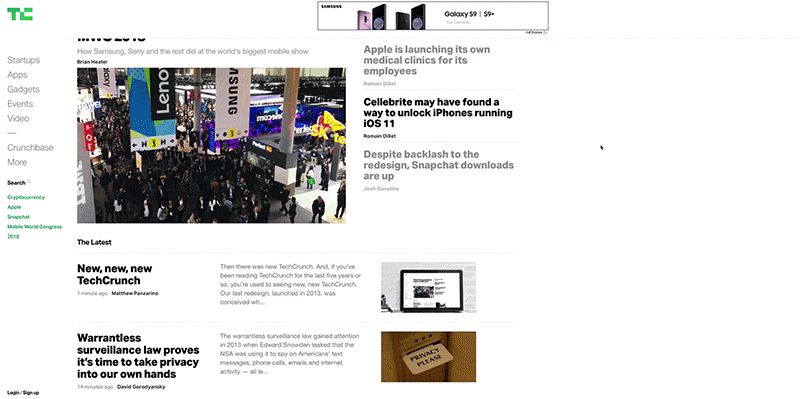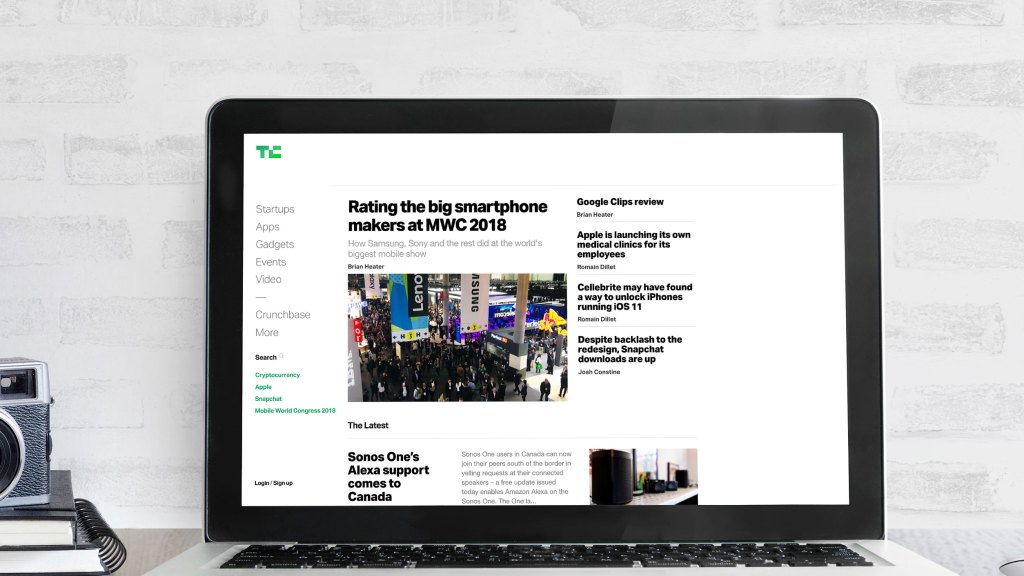In the beginning, there was TechCrunch.
Then there was new TechCrunch. And, if you’ve been reading TechCrunch for the last five years or so, you’re used to seeing new, new TechCrunch. Our last redesign, launched in 2013, was conceived when iOS was still Skeuomorphic and responsive web design was forward thinking. It’s served us well, but the internet never stands still and neither do we.
Today, we’re launching new, new, new TechCrunch to about 10 percent of our readers. If you’re in that group, you’re going to see a very, very 1.0 version of our new site that we’re going to build on over the next few years to deliver what we hope is an experience that aligns perfectly with what we cover as well as how we cover it.
The premise of TechCrunch has always been built around seeing things first. If you want to know about the companies that will be profiled next year in the weekend tech sections of big newspapers, or see and hear from the founders that will trot out onto the stage of a vanity project design conference 18 months down the line, you read TechCrunch now and you come to our Disrupt conferences now.
We make it our business to wade into the ocean of new companies, technologies, founders and investors that make up the worldwide community of early stage startups and absorb as much as we can as early as we can. We’re the ‘tip of the spear’ in many of these cases, and it’s our job to parse these topics, give you context and have an ongoing conversation in clear, plain language with you.
When we know it, you know it. Back in 2009, TechCrunch founder Michael Arrington made the case for what has been coined process journalism and Jeff Jarvis summed it up succinctly, saying that “newspaper people see their articles as finished products of their work. Bloggers see their posts as part of the process of learning.”
No matter what you call it, the shape of it is really a conversation between the reader and the writer. As the word blogging has become a pejorative and the impact of decisions made about technology have been made dramatically and frighteningly clear, I believe that the overall shift has been away from having conversations and towards pontification. Over the past couple of years, the tech journalism meter has been pegged all the way over at cynical, knowing smugness, which doesn’t do much to invite people in and encourage discussion about the way that technology is built, funded and developed.
Instead, our way is to approach technological topics from a place of healthy skepticism, but genuine optimism as well. Technology is not going to magically stop or disappear. It will only get more powerful and more important. So it’s our job to examine the power structures that bring it into existence and examine the sociological and business advantages that greater awareness, more organic cultural connections to the societies that they will eventually serve and a diverse and inclusive engineering culture can make for better tech. You can’t do that from on top of the mountain. You have to get out here and wade through it with the builders.
The TechCrunch philosophy is to stay close enough to feel the heat without getting hypnotized by the flames. We’re not always perfect or right, but we’re willing to be here, to really understand it and to make an honest attempt to help others to.
All newsrooms are or should be evaluating how to handle the rapidly shifting sands of tech news, but the core fact is that these conversations have no end. Even when a company closes up shop or gets acquired the diaspora of talent, money and technology may have reverberations down the line.
And the product of journalism has not kept up with the need to have these conversations. When we began designing the new, new, new TechCrunch, the desire to have the site support rapid-fire, stream-of-understanding journalism in a way that could be presented as a conversation supported by context was the theological underpinning. Everything else was designed around that idea.
Just like the companies that we cover here at TechCrunch, what we’re shipping isn’t perfect. I’m sure a ton of people reading this are probably taking a break from coding, launching, building, shipping and tweaking products. That’s why we’re launching with what we consider to be an MVP version of TechCrunch. We want you to check it out, let us know what you think and stress test it. This is a beta, a beginning. But we think it’s pretty cool. We’ll have more to say about the site and all of its features, as well as how we went about building it, in the future.
For now, here are some things to look out for as more and more of you begin to see it.

Exactly what needs to be there and no more
The new, new, new TechCrunch is an empty bucket. We’re going to fill it up over time with the things that we need, but mostly with pure content. We’ve stripped away all of the extra visual crud that tends to wash up onto the shores of a website and stick to it. There’s the main feed, some simple navigation and a couple of modules that we can play with. Otherwise it’s there to support the content, not to impress you with our CSS skillz.
There are no pages on TechCrunch
Well, almost no pages. Page views are a BS metric favored by people who love to game the system. TechCrunch is focused instead on engaging our readers by shipping genuine scoops, analysis and context and compelling conversations that keep you glued to the site. We have a huge amount of readers that visit us monthly, weekly and even daily because they know that we’re pushing out a real-time feed of the things that fascinate us about tech inside and outside of Silicon Valley.
This is all delivered in a single stream that will allow you to jump into and out of articles without losing your place in the overall conversation. You’ll never be out of context. And when they’re done, no infinite scroll onto some other random article, because you’ve never left the home page of TC where the newest stuff lives.
A conversational structure
As I mentioned above, a key desire for us was to be able to have conversations with readers about stories that are developing in real time. To that end, we’ve developed story groups that allow us to link topics together into clusters and threads that will give readers the ability to jump into the middle of an ongoing conversation and be instantly provided with the context that they need to catch up and forge ahead.
There are more features on the site that help readers to parse things like funding news and to see Disrupt and Battlefield event experiences that morph depending on whether you’re visiting them before, during or after they take place. The project has gone more than skin deep, we’ve also modernized the technologies we’re using, capitalizing on advancements in the WordPress platform to use it as a headless CMS powering an all-new React frontend. We’re excited about the potential for innovation that this creates. Our head of product, Nicole Wilke, will speak more to this later.
For now, the lucky 10 percent gets a preview and we’ll roll it out to more of you over time. It’s a work in progress, just like tech, but we hope you like where it’s going.































Comment